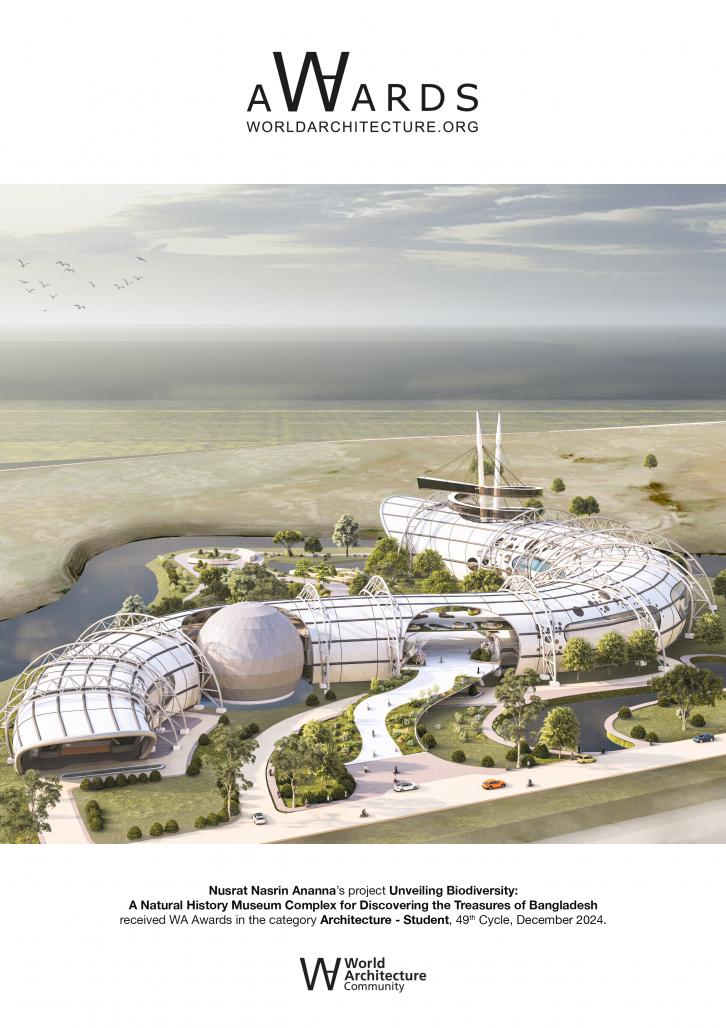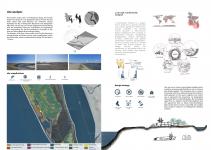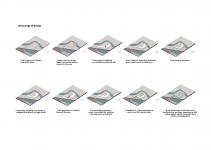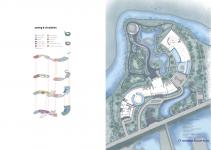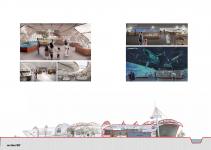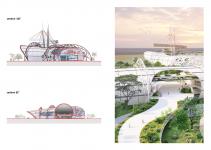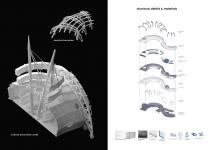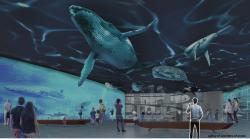The Natural History Museum Complex in Teknaf, Cox’s Bazar, Bangladesh, serves as an innovative and comprehensive hub for the exploration and preservation of the region's rich biodiversity. Situated in a biodiversity hotspot, this complex integrates marine, inland water, and terrestrial ecosystems, creating a dynamic journey through various environmental galleries. This project aims to design an educational and research-oriented facility that not only showcases the diverse flora and fauna of Bangladesh but also contributes to their conservation and scientific study.
In order to represent ecological damage brought on by human activity, the museum's architecture was inspired by decomposed whale carcasses found near the Cox's Bazar shoreline. A steel construction system that reflects the museum's ecological narrative and is resilient in the cyclone-prone climate is an outcome of this idea. The form complements the location, embracing the surrounding natural beauty and merging in perfectly with the coastline scenery. The project's design philosophy relies on sustainability and site sensitivity. To preserve the delicate coastal environment, underground construction is purposefully avoided, and materials are selected to limit heat gain, which lessens the impact on the environment while increasing energy efficiency. The building's landscaping honors the area's ecological variety while blending in with the surrounding landscape, resembling the river deltas that shape Bangladesh's geography.
The journey of the visitors starts with an entrance ramp which connects them to the sea view and the surrounding landscape. There are five immersive galleries at the museum which are designed to promote learning, consciousness, and interaction with nature. Visitors are introduced to unique and endemic species in the Hall of Treasures, which emphasizes Bangladesh's special ecological value as a hub for biodiversity. The wonders of ocean explores the many aquatic habitats of marine life, coastal areas, and coral reefs. The Land Pavilion highlights terrestrial biodiversity by exhibiting forests, fauna, and native plants, while the Inland Water Odyssey focuses on the diverse life nourished by rivers and wetlands. Last but not least, the Future of Biodiversity gallery highlights endangered species and encourages sustainable habits while offering a forward-looking perspective on conservation efforts. In addition to its galleries, the museum features a variety of areas intended to enhance the experience of visitors and advance research and instruction. A modern research facility supports innovative biodiversity conservation projects and provides a forum for cooperation between scientists, conservationists, and students. Using cutting-edge technology, the virtual experience hub connects visitors with far-off habitats and species to offer interactive digital excursions of remote environments. The scientific gallery, which was created especially for visitors and students, provides experiential learning opportunities that stimulate interest and exploration. A multipurpose hall is an engaging venue for sharing research outcomes to the community for betterment in agriculture and aquaculture. This also allows cultural events, and educational activities that encourage communication and cooperation amongst a range of audiences. Furthermore, visitors can take advantage of a 360-degree observatory that gives breathtaking panoramic views of the hills and sea, creating a calm environment for introspection and a closer bond with the natural world. There is also a restaurant with a view to seaside landscape.
This museum serves as a venue for community involvement, education, and advocacy in addition to being a place for exhibitions. It spreads knowledge about the value of biodiversity and the mutual reliance of ecosystems through interactive exhibits, multimedia displays, and educational programs. The galleries are intended to fascinate visitors and encourage them to actively participate in conservation initiatives. The project closes the gap between academia and public education by including a dedicated research dimension, which makes it possible to share scientific knowledge with a larger audience. The museum's community-focused areas, such the science gallery and multipurpose hall, enhance its function as a center of culture and education while encouraging a sense of accountability and ownership among both domestic and foreign tourists.
The design approach places a high value on harmony with the environment, making sure that the delicate coastal scenery is not overly disturbed. The idea avoids underground construction because of the area's ecological value, maintaining the equilibrium of the neighboring ecosystems. With long-lasting materials that guarantee longevity and safety, the structural system is meticulously designed to withstand the area's vulnerability to cyclones. The project's dedication to environmental preservation is demonstrated by the careful use of sustainable design techniques, from material selection to energy-efficient equipment. The museum is a prime example of how architecture can be a force for beneficial change by resolving global issues like biodiversity loss by minimizing its ecological footprint.
The Natural History Museum Complex in Cox's Bazar is a source of inspiration and optimism, showing how design can promote education, conservation, and community involvement while addressing pressing ecological issues. The museum provides a venue for discovering the multifaceted beauty of Bangladesh's biodiversity with its immersive galleries, contemporary amenities, and sustainable design. It encourages tourists to appreciate the value of conserving nature and gives them the motivation to take significant steps to save it for the future. This project bridges the gap between awareness and action by taking a comprehensive approach to influencing people, education, and conservation.
2024
Teknaf, Cox’s Bazar is a coastal region that is a vital ecological site. To preserve the area, extensive subterranean building is deliberately avoided. Invasion of the foundation and substructures is minimal. For minimally invasive substructures, marine-grade concrete with corrosion- and salinity-resistant additives (such as pozzolanic additives or corrosion inhibitors) is utilized. There is very minimal disturbance even at ground level. Because the building's ground area makes up less than 20% of the entire site, it allows for diligent planting that gives guests a real ecological experience without endangering the ecosystem. There is embankment at the coastline and the site is already elevated at least 15 feet from mean sea level by sand filling and stabilizing the soil.
For superstructures reinforced cement concrete structures are used with a shell. Aluminum composite panel sheet serves as the shell's sheeting material. Because of its strength, adaptability, and environmentally beneficial qualities, aluminum composite panels or ACPs are being utilized more and more in coastal regions and sustainable construction projects. ACP sheets are ideal for usage in coastal areas because of their strong resistance to corrosion brought on by moisture and seawater. For further defense against oxidation and corrosion, polyester resin or PVDF (polyvinylidene fluoride) is applied to the aluminum layers. Strong winds, heavy rainfall, and UV rays—all of which are typical in coastal areas can be tolerated by ACP panels. Long periods of exposure to sunlight and salty air do not cause them to distort, peel, or deteriorate. Effective thermal insulation from ACP sheets lowers heat gain in structures. This reduces the amount of energy needed for cooling, particularly in hot coastal regions. Aluminum and polyethylene, two recyclable components, are used to make ACP panels. The environmental impact of recycling aluminum is greatly reduced because it only uses 5% of the energy required to generate new aluminum. It is also smooth, non-porous, easy to clean, and aesthetically pleasing, all of which blend in well with the seaside landscape. It is lightweight and durable, which lowers the overall structural load. it is also fire resistant and its production ensures low carbon footprint.
For this project, where long spans, durability, and cyclone protection are crucial, using an exoskeleton steel truss system has many of benefits. The steel's performance in the coastal environment is further improved by coating it to prevent oxidation. It creates open, flexible areas ideal for exhibition galleries by providing effective structural supports and distributing loads equally. As steel trusses are so durable and lightweight, they can support the heavy wind loads that are common in Teknaf's cyclonic conditions. By allowing airflow through the structure, the exoskeleton truss system minimizes uplift forces during cyclones and reduces wind resistance. In the coastal climate of Teknaf, oxidation brought on by the salt-laden air is prevented by applying a protective coating (galvanization or polyvinylidene fluoride coating). The 360 observatory is basically a spiral ramp supported by two slanted columns with steel cables.
Multilayered glare-free ETFE glass enhances the structure and creates a more comfortable environment for exhibitions and visitors by letting in natural light and preventing glare. Its strength and light weight allow it to survive coastal conditions including storms, UV radiation, and salty air while also lowering structural load. Its thermal insulation lowers cooling costs, and its self-cleaning surface minimizes maintenance. Because it is recyclable, flexible, and encourages sustainable building practices, ETFE is a fantastic choice for Teknaf's surroundings.
There are service elevators on either side of the entrance ramp, and service carts are available throughout the structure. The Natural History Museum's elements are gathered through field collections, donations, partnerships, or rescue operations in accordance with legal and ethical guidelines. To prevent decomposition, specimens are handled, cataloged, and stored in controlled environments after collection. These elements are crucial for taxonomic research, ecological studies, and comparative analysis, which advances our understanding of biodiversity, climate research, and conservation efforts. While some specimens are used by researchers for publications, medicinal applications, and educational purposes, others are displayed in galleries to engage the general public.
Name: Nusrat Nasrin Ananna
Studio tutors: Dr. Sajal Chowdhury, Rezuana Islam
Supervisor: Sarah Binte Haque
Unveiling Biodiversity: A Natural History Museum Complex for Discovering the Treasures of Bangladesh by Nusrat Nasrin Ananna in Bangladesh won the WA Award Cycle 49. Please find below the WA Award poster for this project.

Downloaded 0 times.
Favorited 1 times
